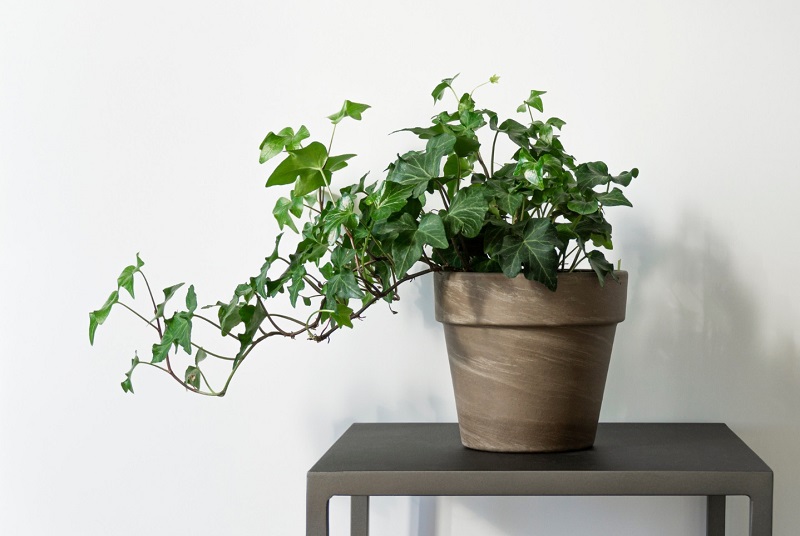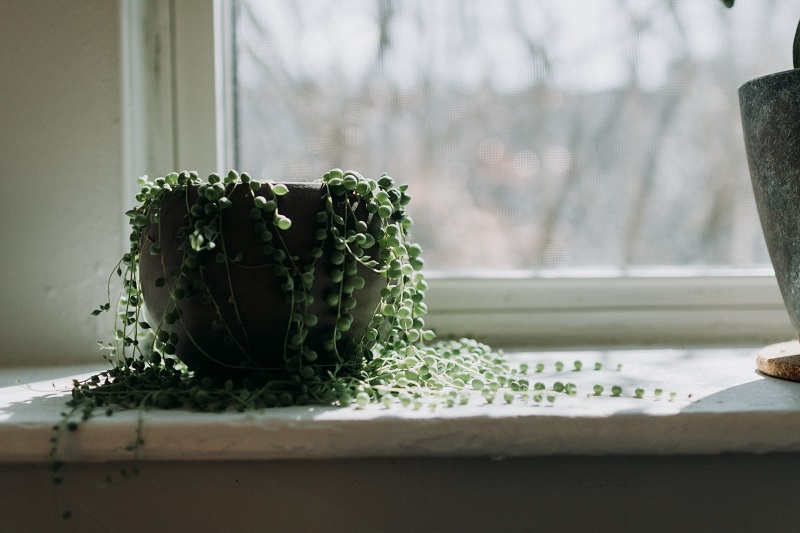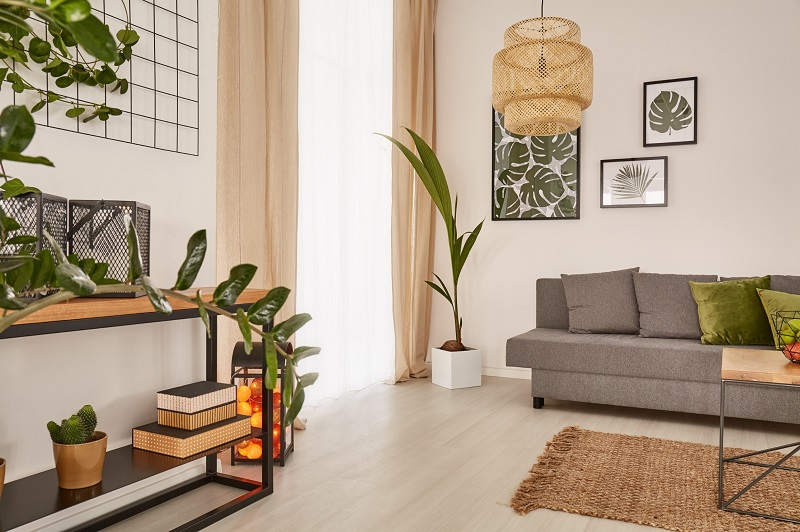Living in a home where space is limited doesn’t mean you have to forego the benefits of houseplants. You can still create a calming green indoor oasis that meshes well with your layout and décor with the right selection of plants.
Houseplants not only bring a touch of nature indoors but also provide numerous health benefits. In this article, we explore the best houseplants that are well-suited for small interior spaces, offering beauty, functionality, and easy maintenance.
Table of Contents
- Benefits of Houseplants in Small Interior Spaces
- What to Consider When Selecting Houseplants for Small Rooms
- 10 Houseplants Perfect for Small Interior Spaces
- Conclusion
Also see:
- 8 Spa Décor Ideas to Make Your Home More Comfortable & Relaxing
- How to Design a Low-Maintenance Garden in 5 Simple Steps
- 5 Stylish Ideas to Make Your House Look New & Feel Like Home
- More Recommended Interior Design & Home Décor Articles
- Related Topics: Gardening | Interior Design | Home Décor | Home Wellness
Benefits of Houseplants in Small Interior Spaces
Well-suited and selected houseplants can offer several benefits to small interior spaces:
- Improved Air Quality
- Enhanced Aesthetics
- Stress Relief
- Increased Productivity
- Humidity Regulation
- Sound Absorption
Improved Air Quality
Houseplants act as natural air purifiers, absorbing harmful toxins and releasing oxygen. They can help eliminate pollutants commonly found in indoor environments, such as formaldehyde and benzene.

Leaves and flowers of a Peace Lily
Also see:
Enhanced Aesthetics
Natural greenery adds a vibrant and visually appealing touch of biophilic design to small interior spaces. Houseplants bring life and color to any room, making it feel more inviting and cozy.

Also see:
Stress Relief
Research suggests that being around nature and plants can reduce stress levels and promote a sense of well-being. Houseplants have a calming effect on individuals, creating a peaceful atmosphere.

Closeup view of a Jade Plant
Also see:
Increased Productivity
Studies have also shown that having plants in work or study areas can enhance focus, concentration, and productivity. Houseplants can help create a more conducive environment for tasks that require mental effort.

Also see:
Humidity Regulation
Certain houseplants release moisture through their leaves, which can help increase humidity levels in dry indoor spaces. This is particularly beneficial during the winter months when heating systems can cause the air to become dry.

Sound Absorption
Some houseplants have the ability to absorb and dampen sound, reducing background noise and creating a quieter indoor living environment.
Also see:
What to Consider When Selecting Houseplants for Small Rooms
When selecting houseplants for small rooms and interior spaces, be sure to consider the following factors:
Size and Compactness
Opt for compact houseplants that fit well in small spaces. Look for varieties that have a bushy or trailing growth habit rather than those that spread horizontally.
Light Requirements
Assess the amount of natural light your space receives. Houseplants that thrive in low to moderate light conditions are often well-suited for small rooms, as intense sunlight may be less common in smaller interiors. For light-challenged rooms, look into products that can draw natural daylight into hard-to-reach areas of your home, such as Solatube.
Also see:
Care Needs
Consider your schedule and ability to care for plants. Select houseplants that require minimal maintenance, including watering, fertilizing, and pruning. Succulents, for example, are always a good choice for those with busy and unpredictable schedules, as they are drought tolerant and can store ample amounts of water.
Also see:
Allergies and Toxicity
If you or your family members have allergies or pets at home, choose houseplants that are non-toxic and hypoallergenic.
Also see:
10 Houseplants Perfect for Small Interior Spaces
- Snake Plant
- ZZ Plant
- English Ivy
- Peace Lily
- String of Pearls
- Philodendron Green Princess
- Aloe Vera
- Zebra Plant
- Jade Plant
- Echeveria ‘Lola’
Snake Plant
Sansevieria trifasciata
The snake plant is an ideal choice for a small space as its tall, slender leaves shoot upwards, requiring very little horizontal space. The popular Laurentii variety is characterized by the vibrant yellow edges within the upright sword-like leaves.

Snake Plant
Photo by Kara Eads
Moreover, the snake plant is an excellent air purifier, being able to remove several toxins from the air, such as formaldehyde, benzene, xylene, toluene, and nitrogen oxides.
The plant is well-known for being incredibly hardy by tolerating a wide range of lighting conditions, from bright sunlight to low indirect light, and requiring infrequent watering. Given that the snake plant is highly amenable to neglect, it is perfect for people with busy or unpredictable schedules.
Additionally, snake plant propagation is straightforward, as there are four easy ways to grow new snake plants from cuttings, using: water, soil, division, or rhizome.
Snake Plant Highlights
- Common Name: Snake Plant
- Synonyms: Mother-in-Law’s Tongue; St. George’s Sword
- Genus and Species: Sansevieria trifasciata
- Special Traits: Vertical and compact; resilient; requires minimal watering; air-purifying abilities
Also see:
ZZ Plant
Zamioculcas zamiifolia
The ZZ plant is another excellent choice for small spaces due to its compact structure and overall attractiveness. Its glossy, deep green leaves add an instant touch of elegance to any room. Requiring minimal space, the ZZ plant is also remarkably resilient, thriving in both low and bright light conditions.

ZZ Plant
ZZ plants have a slow growth rate, so you won’t have to worry about them outgrowing your space quickly. Furthermore, ZZ plants are a popular choice for many indoor gardeners as they are drought-tolerant, ease to care for, and provide stunning aesthetic appeal.
ZZ Plant Highlights
- Common Name: ZZ Plant
- Synonyms: Zanzibar Gem, Zuzu Plant
- Genus and Species: Zamioculcas zamiifolia
- Special Traits: Compact; slow growth rate; resilient; drought-tolerant; nice aesthetic appeal
English Ivy
Hedera helix
English Ivy is a versatile and adaptable plant that suits small spaces well. Its trailing growth habit allows it to be used in hanging baskets or trained to climb a trellis, making efficient use of vertical space. English Ivy is also known for its fantastic air-purifying abilities, filtering out pollutants like benzene and xylene.

English Ivy
This plant requires moderate sunlight while preferring cooler temperatures. The plant will need regular watering, especially during the growing season, but it’s generally requires minimal maintenance.
English Ivy Highlights
- Common Name: English Ivy
- Synonyms: Algerian Ivy, Baltic Ivy, Branching Ivy ,California Ivy, Common Ivy, Glacier Ivy, Needlepoint Ivy, Sweetheart Ivy
- Genus and Species: Hedera helix
- Special Traits: Versatility; air-purifying abilities; ideal for vertical spaces
Peace Lily
Spathiphyllum ‘Mauna Loa’
The Peace Lily, with its stunning white flowers and dark green foliage, is a beautiful addition to any small space. Its compact growth habit makes it an excellent choice for areas with space restrictions. Besides its aesthetic appeal, the Peace Lily is also a highly effective air purifier, removing toxins like formaldehyde, trichloroethylene, and benzene from the air.

Peace Lily
The Peace Lily prefers low to moderate light and requires regular watering. However, it’s also forgiving if you occasionally forget to water it, making it a suitable choice for those new to gardening.
Peace Lily Highlights
- Common Name: Peace Lily
- Synonyms: Spathe Flower, White Sails
- Genus and Species: Spathiphyllum
- Special Traits: Compact growth; prefers regular watering, but can handle breaks; effective air purifier
- Ideal Room Traits: Rooms with low to moderate light
String of Pearls
Senecio rowleyanus
The String of Pearls is a charming succulent that brings an appealing touch of whimsy to small spaces. True to its name, this plant features dainty, bead-like leaves cascading down slender stems, giving the impression of a string of green pearls. These trails can extend up to three feet, making the plant a perfect choice for hanging baskets or high shelves.

String of Pearls
Photo by Kelly Sikkema
This succulent is drought-tolerant and thrives in bright, indirect light, so placing it near a window is ideal. While it requires a well-draining soil mix and infrequent watering, it’s care is generally quite easy.
String of Pearls Highlights
- Common Name: String of Pearls
- Synonyms: Rosary Vine, Irish Beads, Green Peas, String of Beads, String of Marbles, String of Peas, Bead Plant, Rosary Pearls, Necklace Plant
- Genus and Species: Senecio rowleyanus
- Special Traits: Drought-tolerant; fantastic air purifier; easy care; works well for vertical spaces
- Ideal Room Traits: Bright rooms with high shelving
Philodendron Green Princess
Philodendron Selloum ‘Green Princess’
The Philodendron Green Princess is an elegant aesthetic solution with its lush vibrant foliage and neat growth habit that won’t overpower your limited space while still providing a visually stunning and calming presence. Its air-purifying qualities, compact size, and relatively easy care requirements make it an ideal choice for small spaces.

Philodendron Green Princess
The Green Princess thrives in bright, indirect light. Place it near a window where it can receive filtered sunlight. If your small space lacks natural light, you can supplement it with artificial lighting, such as fluorescent lights or grow lights, placed a few feet above the plant.
Philodendrons also enjoy moderate to high humidity, so misting the leaves occasionally or placing a humidifier nearby can help create the optimal environment.
Philodendron Green Princess Highlights
- Common Name: Philodendron Green Princess
- Synonyms: Philodendron Green
- Genus and Species: Philodendron Selloum ‘Green Princess’
- Special Traits: Lush foliage; neat growth habit; calming presence
Aloe Vera
Aloe barbadensis
Aloe Vera is a versatile succulent with thick, spiky leaves that contain a soothing gel. It thrives in bright light and requires minimal watering. Aloe Vera not only adds a decorative touch to any small interior space but it also serves as a natural first aid kit.

Aloe Vera
The gel inside the plant’s leaves can be used to soothe minor burns, cuts, and skin irritations, making it ideal to place in either a bright kitchen or other easily accessible part of your home.
Aloe Vera Highlights
- Common Name: Aloe Vera
- Synonyms: Babosa, Barbados Aloe, Cape Aloe, Curaçao Aloe, Chinese Aloe
- Genus and Species: Aloe barbadensis
- Special Traits: Soothing gel for minor burns, cuts and skin irritations; drought-tolerant; compact; low maintenance
- Ideal Room Traits: Bright rooms that are centrally-located
Zebra Plant
Haworthia Fasciata
The Zebra Plant is a small succulent with distinctive white stripes on its dark green leaves. It thrives in bright, indirect light and is well-suited for small containers or terrariums. The Zebra Plant has a slow growth rate, making it ideal for confined spaces.

Zebra Plant
Zebra Plant Highlights
- Common Name: Zebra Plant
- Synonyms: Zebra Cactus, Zebra Haworthia
- Genus and Species: Haworthia Fasciata
- Special Traits: Distinctive white stripes; slow growth rate; drought-tolerant; compact
- Ideal Room Traits: Small spaces, such as desks and small tables
Jade Plant
Crassula Ovata
The Jade Plant is a classic succulent with thick, fleshy leaves that resemble jade stones. It’s a popular choice for small spaces due to its compact size, ability to tolerate low light conditions and easy care. The Jade Plant is also known for its calming-to-the-touch texture, and being very easy to propagate. It is also believed to bring good luck and prosperity by many cultures.

Jade Plant
Jade Plant Highlights
- Common Name: Jade Plant
- Synonyms: Lucky Plant, Money Plant, Money Tree
- Genus and Species: Crassula Ovata
- Special Traits: Pleasing to the touch; drought-tolerant; compact; aesthetically calming
- Ideal Room Traits: Small spaces, such as window sills, desks and shelving
Echeveria Lola
Echeveria Lola is a stunning rosette-forming succulent with pastel pink and blue-green leaves. Its compact size and symmetrical shape make it an excellent choice for small interior spaces, including windowsills and shelves. The Lola Succulent requires bright light to maintain its vibrant colors.

Echeveria Lola succulent plants
Echeveria perle von Nurnberg is another popular type of Echeveria succulent characterized by a single rosette of paddle-like, pastel leaves. In full and direct sunlight conditions, its leaves turn bright pink and purple.
Echeveria Lola Highlights
- Common Name: Echeveria Lola
- Synonyms: The Lola Succulent, Mexican Hens and Chicks, Mexican Snowball
- Genus and Species: Echeveria ‘Lola’
- Special Traits: Colorful pastel rosette of paddle-like petals; drought-tolerant; compact; ideal for small stone succulent gardens
- Ideal Room Traits: Small spaces, such as window sills, desks and shelving
Conclusion
Even if you’re living in a small space, there’s no reason not to indulge your green thumb. By choosing the right houseplants like the Snake Plant, ZZ plant, English Ivy, and Peace Lily, you can maximize your greenery without requiring too much time and effort. Not only will these plants improve your overall home wellness, they will make your home feel comforting and stylish, as well.

More Recommended Interior Design & Home Décor Articles
- 3 Interior Design Features of UK Homes We Love in the US
- Top 5 Color Schemes for Your Living Room
- How to Apply Transformable Interior Design to Your Home
- Hidden Doors: A Secret Example of Transformable Design
- 8 Wellness Design Tips for Your Kitchen & Bath
- Related Topics: Gardening | Interior Design | Home Décor | Home Wellness
| Purgula is reader-supported. When you click on links to other sites from our website, we may earn affiliate commissions, at no cost to you. If you find our content to be helpful, this is an easy way for you to support our mission. Thanks! Learn more. |







